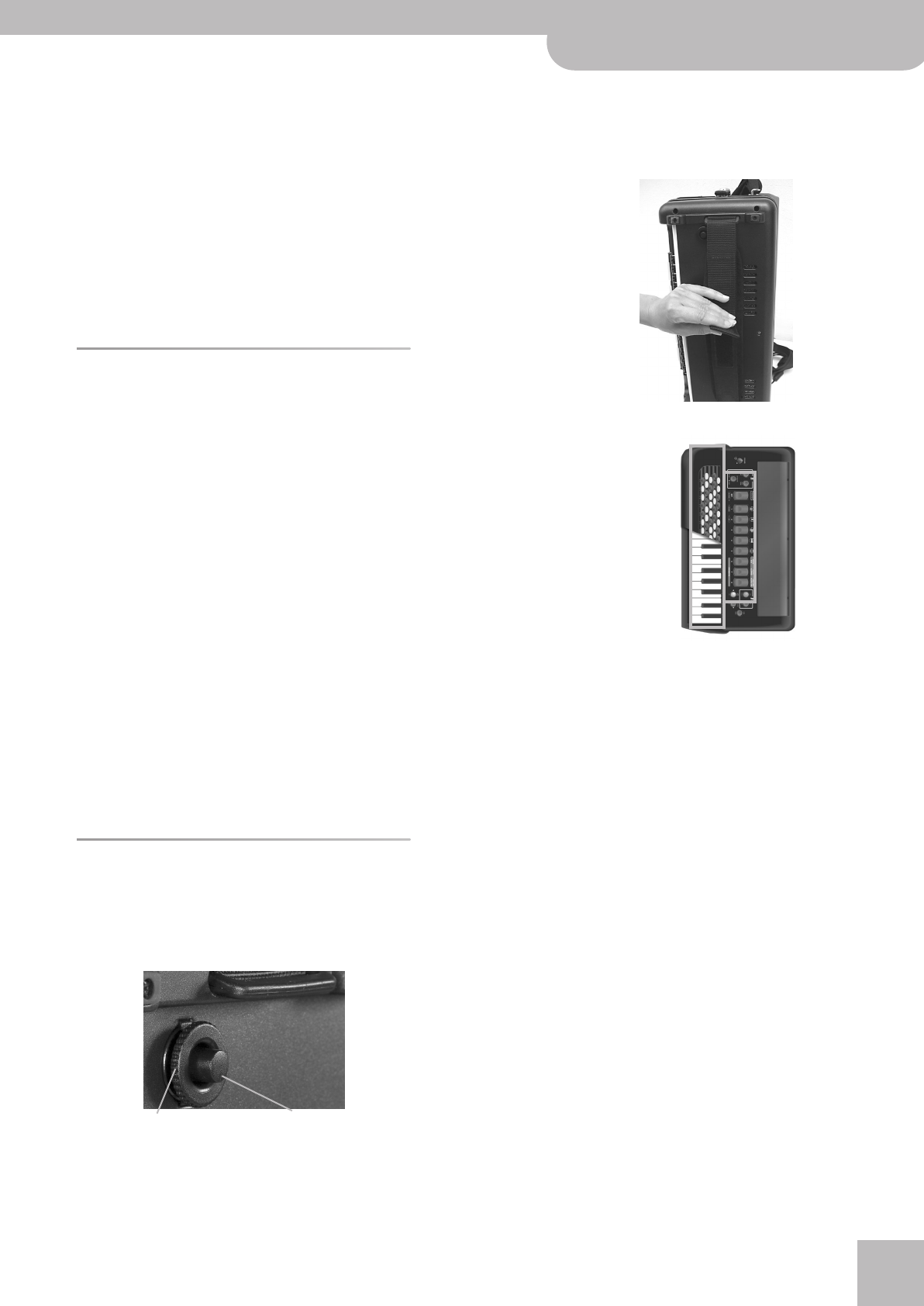
Listening to the demo songs
V-Accordion
r
11
Note: You can also connect headphones to the PHONES
socket, in which case you do not need to establish an audio
connection.
(4) Turn the FR-2/FR-2b’s [VOLUME] knob A from the
“POWER OFF” position towards the right.
(5) Switch on the receiving audio device.
(6) Start playing.
—To switch off your system—
(7) Turn down the output volume of the receiving
audio device, or switch it off.
(8) Turn the FR-2/FR-2b’s [VOLUME] knob all the way
to the left (“POWER OFF”).
Listening to the demo songs
One of the most striking aspects of your V-Accordion
may be that it can play all by itself! It contains a series
of demo songs that illustrate its wide variety of sounds
and applications. Here is how to listen to the demo
songs:
(1) Switch on the FR-2/FR-2b.
See “Switching the power on and off” on p. 10.
(2) Press and hold the [SONG÷DEMO] button J.
Playback starts automatically with the first demo
song (there are 16 demo songs in all). At the end of
the first song, the FR-2/FR-2b starts playing songs 2,
3 etc. You can also directly jump to the song you’re
interested in:
(3) Use the [USER¥PROG÷DEC] and [METRONOME÷INC]
buttons H to select the demo song you want to
listen to.
(4) Use the [VOLUME] knob A to change the volume if
it is too loud or too soft.
Note: All demo songs are copyright ©2007 by Roland Europe.
Public performance or recording of these songs is prohibited.
(5) Press [SONG÷DEMO] J again to leave demo song
mode.
Touring the FR-2/FR-2b’s sections
Bellows resistance regulator
Your FR-2/FR-2b is equipped with a bellows resistance
regulator knob that allows you to specify the bellows’
inertia (the force needed to push and pull it).
Located next to one of the bellows clips and mounted
onto the air button (which allows you to release
remaining air from the bellows without producing
sound). Setting it allows you to choose a lighter or
stronger inertia. Choose the setting that feels most
comfortable for you.
Bass strap
The FR-2/FR-2b’s bass strap
(used to move the bellows in
and out) is made of fabric
and fitted with a Velcro strip
that allows you to adjust its
slack:
Treble section
The Treble section can be played
using the 34-key “piano” keyboard
(FR-2) or the 82 treble buttons
(FR-2b).
The sound it produces is deter-
mined by the register ([1]~[8]) you
pressed last. This section can be
used as “accordion” or to play an
orchestral sound.
(1) Connect the FR-2/FR-2b to an
amplifier and switch it on.
See p. 10.
(2) Grab the FR-2/FR-2b, press a Treble register and
start playing on the keyboard.
Though the FR-2/FR-2b is an electronic musical
instrument, it only produces sound when you move
the bellows.
Note: When the FR-2/FR-2b is controlled via MIDI, there is no
need to move the bellows.
(3) Press the [SET] register E (it flashes blue).
(4) Press one of the registers [1]~[8] F to select a Set
memory.
The [SET] button goes dark.
Note: If you don’t press any register while the [SET] register
flashes in blue, it will go dark again after a while. If you pressed
the [SET] register by accident, press it again so that it goes dark.
Note: See also the note about Set 5 on page 7.
(5) Play a few notes to audition the sound.
(6) Press one of the registers [1]~[5] to select another
register. See page 7.
(7) Press the same register again to select the “b”
sound.
Press it yet again to revert to the “a” sound.
Each time you press a different register, the FR-2/
FR-2b will automatically select the “a” sound
(8) If you think the sound is too loud or too soft, you
can change the setting of the [VOLUME] knob A.
Bellows resistance regulator. Turn to
select the bellows’ resistance.
Air button. Press to purge remaining
air after playing.
FR-2+b GB.book Page 11 Tuesday, August 7, 2007 11:19 AM


















